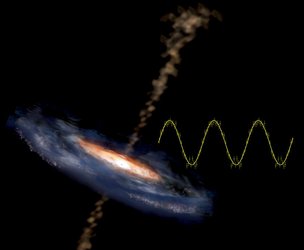XMM-Newton and Integral clues on magnetic powerhouses
X-ray and gamma-ray data from ESA’s XMM-Newton and Integral orbiting observatories has been used to test, for the first time, the physical processes that make magnetars, an atypical class of neutron stars, shine in X-rays.
Neutron stars are remnants of massive stars (10-50 times as massive as our Sun) that have collapsed on to themselves under their own weight. Made almost entirely of neutrons (subatomic particles with no electric charge), these stellar corpses concentrate more than the mass of our Sun within a sphere about 20 km in diameter.
They are so compact that a teaspoon of neutron star stuff would weigh about one hundred million tons.
They are so compact that a teaspoon of neutron star stuff would weigh about one hundred million tons. Two other physical properties characterise a neutron star: their fast rotation and strong magnetic field.
Magnetars form a class of neutron stars with ultra-strong magnetic fields. With magnetic fields a thousand times stronger than that of ordinary neutron stars, they are the strongest known magnets in the cosmos.
In comparison, one would need 10 million million commonly-used hand magnets to generate a comparable magnetic field (most media used for data storage, for example, would be erased instantly if exposed to a magnetic field a mere million million times weaker).

So far, about 15 magnetars have been found. Five of them are known as soft gamma repeaters, or SGRs, because they sporadically release large, short bursts (lasting about 0.1 s) of low energy (soft) gamma rays and hard X-rays. The rest, about 10, are associated with anomalous X-ray pulsars, or AXPs. Although SGRs and AXPs were first thought to be different objects, we now know that they share many properties and that their activity is sustained by their strong magnetic fields.
One would need 10 million million commonly-used hand magnets to generate a comparable magnetic field
Magnetars are different from ‘ordinary’ neutron stars because their internal magnetic field is thought to be strong enough to twist the stellar crust. Like in a circuit fed by a gigantic battery, this twist produces currents in the form of electron clouds which flow around the star. These currents interact with the radiation coming from the stellar surface, producing the X-rays.

Until now, scientists could not test their predictions, because it is not possible to produce such ultra-strong magnetic fields in laboratories on Earth.
To understand this phenomenon, a team led by Dr Nanda Rea from the University of Amsterdam used XMM-Newton and Integral data to search for these dense electron clouds around all known magnetars, for the first time.
Rea’s team found evidence that large electron currents do actually exist, and were able to measure the electron density which is a thousand times stronger than in a ‘normal’ pulsar. They have also measured the typical velocity at which the electron currents flow. With it, scientists have now established a link between an observed phenomenon and an actual physical process, an important clue in the puzzle of understanding these celestial objects.
The team is now working hard to develop and test more detailed models on the same line, to fully understand the behaviour of matter under the influence of such strong magnetic fields.
Notes for editors:
The team includes Dr Silvia Zane, from University College London, Prof. Roberto Turolla from the University of Padua, Prof. Maxim Lyutikov from Purdue University, and Dr Diego Gotz from CEA-Saclay.
The results appear in ‘Resonant cyclotron scattering in magnetars’ emission’, by N. Rea, S. Zane, R. Turolla, M. Lyutikov and D. Gotz, published in the Astrophysical Journal on 20 October 2008.
The XMM-Newton science teams are based in several European and US institutes, grouped into three instrument teams and the XMM-Newton Survey Science Centre (SSC). Science operations are managed at ESA’s European Space Astronomy Centre (ESAC), at Villanueva de la Cañada near Madrid, Spain. Spacecraft operations are managed at ESA’s European Space Operations Centre (ESOC) in Darmstadt, Germany.
For more information:
Nanda Rea, Anton Pannekoek Institute, University of Amsterdam
Email: N.Rea @ uva.nl
Norbert Schartel, ESA XMM-Newton Project Scientist
Email: Norbert.Schartel @ esa.int
Christoph Winkler, ESA Integral Project Scientist
Email: Christoph.Winkler @ esa.int















 Germany
Germany
 Austria
Austria
 Belgium
Belgium
 Denmark
Denmark
 Spain
Spain
 Estonia
Estonia
 Finland
Finland
 France
France
 Greece
Greece
 Hungary
Hungary
 Ireland
Ireland
 Italy
Italy
 Luxembourg
Luxembourg
 Norway
Norway
 The Netherlands
The Netherlands
 Poland
Poland
 Portugal
Portugal
 Czechia
Czechia
 Romania
Romania
 United Kingdom
United Kingdom
 Slovenia
Slovenia
 Sweden
Sweden
 Switzerland
Switzerland





































